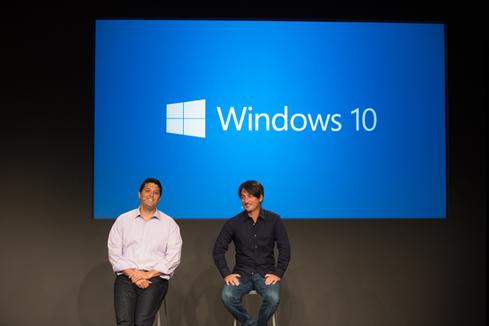IT Leaders Need Split Personality, Gartner SaysIT Leaders Need Split Personality, Gartner Says
IT leaders need to keep building solid, reliable systems, while also devoting more attention to digital experimentation.


Windows 10: 11 Big Changes
Windows 10: 11 Big Changes (Click image for larger view and slideshow.)
It turns out having a mental breakdown is a perfectly rational reaction to the stresses of IT leadership. Developing a split personality might be the only way for your IT organization to cope with the demands of digital business, according to the folks at Gartner Inc.
One of the main themes at this year's Gartner Symposium conference in Orlando, Fla., is that every business is now a technology business and every budget is now a technology budget. Gartner talks about change being accelerated at the nexus of four forces -- social, mobile, cloud, and information -- making technology integral to our lives, our businesses, and our products.
Two top Gartner analysts, Peter Sondergaard and Daryl C. Plummer, outlined the big-picture vision of transformation, with Sondergaard describing "seismic shifts" that will produce real and lasting change. Human behavior itself is changing as digital interaction becomes ever more important, to the point where the first thing many people do in the morning is interact with the virtual world through a phone or a tablet, Sondergaard said. "Nothing gets more attention than the screen, not the boss, and not the spouse -- it's OK, you can admit it."
Winning businesses must cater to digital consumers who will be quick to go elsewhere if their needs aren't met, he said.
[Be part of the solution: How CIOs Can Help CMOs Take Technology Leadership.]
The organizations that fail to transform themselves into digital businesses are doomed, but the established businesses that undertake the transformation will have to divide their attention as never before between traditional core activities and more startup-like innovation and risk taking, in Gartner's view.
The trouble is, many enterprise IT organizations are most focused on operational discipline that produces solid, predictable results. The startup culture that allows a digital business to move quickly and adapt to new possibilities introduced by mobile technology or the Internet of Things is very different and more fluid.
Figure 1:  Gartner's Daryl C. Plummer
Gartner's Daryl C. Plummer
"You have to develop a split personality to be part solid and part fluid," Plummer said. The goal of making IT infrastructure rock-solid is what many people have built their careers on, but "the digital world is in constant flow," he said. "Fluidity is the fundamental quality of digital business." It's what allows a digital business "to take advantage of opportunities to leverage serendipity."
Gartner has been talking about "bimodal" strategies for application development for a year or more, but now it has upped the ante by talking about the need for the entire IT organization to be bimodal, meaning it must split its focus between the core services that make other things possible and the more exciting possibilities of digital innovation.
Smart organizations will retool their recruiting and talent development around this imperative, Sondergaard said. "You can't transform your old IT organization into a digital startup, but you can incubate one inside your business."
Those who think their organizations can't act like startups are doing themselves a disservice, Sondergaard said. "You may be thinking, 'Why should I care about digital startups running out of someone's dorm room where they're drinking Jolt cola and living on bad pizza?' But it's not just them. Your business units are acting as technology startups. That's why we're seeing a shift of demand and control away from IT and toward the business units that are closer to the customer...
"There's no doubt that the digital shift threatens many existing businesses." If a business is vulnerable, "it is inevitable that a disruptive digital competitor will accelerate the decline -- unless your organization has the courage to build new digital capabilities yourself," said Sondergaard.
Many businesses are will "put off the investment, hoping against the evidence that new digital competitors won't come along," Sondergaard said, given that the transition often means "lower margins and a major startup investment." For those who delay too long, that could be the road to extinction, he warned.
Success, on the other hand, is likely to look like "a leaner, growing, digital business with less profit -- but one that survives."
Businesses that engage in the more fluid style of technology operations will also be taking on new risks, and some of them will get burned when their shiny, new Internet of Things initiative leads them to field devices that get hacked, Plummer said. The television show Homeland featured a plot point about the hacking of a pacemaker, and incidents like that are inevitably coming. Organizations need to study the risks, do their best to minimize them, but ultimately accept them in order to move forward, he said.
He compared it to the risk of being eaten by a shark -- scary, but rare: "Bad shark attacks usually happen when someone did the wrong thing, like putting on a wet suit and swimming with seals. Here's my tip: Don't do that."
In a breakout session, Gartner analysts Bill Swanton got more into the details of how to embrace Agile development on an enterprise scale. He started by
talking about "the two pizza rule," the rule of thumb attributed to Amazon's Jeff Bezos that a development team should never be so large that you can't feed it with two pizzas. This has been adopted as an informal principle of the Agile methodology, where the focus is on putting small, cross-functional teams to work developing discrete bits of functionality.
The scale of a large enterprise can make it difficult to stick to a pure Agile approach, Swanton said, because the challenges are larger. If a big software project is divided into smaller pieces assigned to individual teams, communication and coordination among the teams becomes a challenge in its own right. Tools such as social collaboration software can help by making it easier for teams and team members to share what they're doing and keep everyone informed.
The bigger challenge for enterprises is breaking away from their traditional modes of operation. "The traditional project management and program management techniques you know and love aren't going to work," said Swanton. The reason for using Agile development in the first place is to create something new, which by definition means the process will revolve around exploration and experimentation, not a well-defined series of project phases leading to a pre-determined goal, he said. "Instead of using top-down management, you've got to build a culture that allows teams to do the right things."
Budgeting for such a project is also challenging, since the cost and scope of work are not known up front. "Instead, you have to define success in terms of the business outcome -- we're going to take a business capability and improve it in some measurable way," Swanton said. "That's basically how you build a business case -- here is what I am trying to accomplish, here's how I will measure it, and here is what I'm trying to create." Development organizations will have to build credibility with the business units funding these initiatives by delivering products that do in fact create new value for the organization, he said.
Some organizations have also shown success establishing an innovation lab chartered to take on these challenges -- although sometimes when that works, it takes on a life of its own and becomes a business unit outside the CIO's control, according to Swanton.
Another habit IT organizations are going to have to break is being unwilling to train employees; they can't expect to be able to hire people who already have a defined skillset. That may work for Microsoft or Cisco certified staffers, but not for the most skilled Agile developers. "When you're looking at how to create supply for a scarce commodity, a lot of that is going to have to be for training," Swanton said. "Then, of course, once you've got them trained, you're going to have to figure out how you're going to keep them.
Attendees I spoke with said they had heard some of this vision from Gartner before, but they are still figuring out the practicalities.
"It's harder to do than it is to understand," said Tom R. Seely of the Campus Crusade for Christ, project management director for the non-profit's digital initiatives. He said he appreciates and agrees with the vision, but "trying to translate it into some operational thing is not as easy as it sounds."
John Flack, an IT architect at the University of South Dakota, said his organization is recognizing that when a faculty member wants to pursue an initiative or wins a grant that involves the use of technology, the standard "get in line" response to staffing those projects is not adequate. "We're not meeting the needs of those people, and we know it," he said. Gartner's concept of a bimodal division of labor is something his organization is talking about but not doing just yet. "The thing is, you don't go from zero to 'agile enterprise' in a heartbeat."
Who wins in cloud price wars? Short answer: not IT. Enterprises don't want bare-bones IaaS for the same reasons they don't buy many $299 PCs at Wal-Mart. Providers must focus on support, not undercutting rivals. Get the Who Wins In Cloud Price Wars? issue of information Tech Digest today. (Free registration required.)
About the Author
You May Also Like






